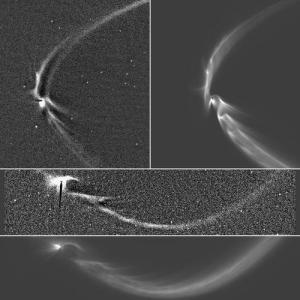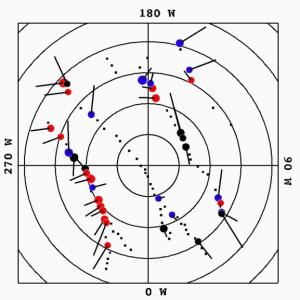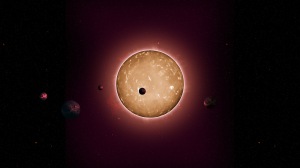Space scientists matched sizes of icy particles erupting from geysers with those in Saturn’s E ring to make discovery
Space news (June 30, 2015) – 237,378 km (147,500 miles) from Saturn

Simulations of the Tendrils
April 14, 2015, Full-Res: PIA17191
+ Labeled version
This collage, consisting of two Cassini images of long, sinuous, tendril-like features from Saturn’s moon Enceladus and two corresponding computer simulations of the same features, illustrates how well the structures, and the sizes of the particles composing them, can be modeled by tracing the trajectories of tiny, icy grains ejected from Enceladus’ south polar geysers.
The figures labeled “a” and “c” are computer-enhanced images of the tendril structures near Enceladus that were taken at high solar phase angle (174 and 170 degrees, respectively); figures “b” and “d” are synthetic (computer-generated) images produced by following the trajectories of tiny, icy particles ejected from the 36 most active geysers (representing the top 50 percent of the moon’s total geyser activity) found on the south polar terrain. The match between real and synthetic images is quite good and strongly supports the suggestion that tendrils are produced by the moon’s geysers.
Electromagnetic effects associated with electrical charges that collect on small grains embedded in a magnetosphere like Saturn’s can modify the grains’ trajectories. These effects are very sensitive to particle size, with smaller particles feeling the effects of charging more strongly than larger ones. The scale of the arc-like structures seen in the tendrils allows scientists to determine that the tendril particles are no smaller than about 0.5 microns (a micron is one millionth of a meter), a size consistent with that of E-ring particles found from other Cassini observations, both imaging and in situ.
Figure “a” is from the observation of 2006; “c” was taken on July 19, 2013, during Cassini’s Earth-imaging event (see The Day the Earth Smiled). Orbital motion is counter-clockwise in all images.
NASA space scientists using images provided by the Cassini spacecraft and computer simulations have created this collage showing long, sinuous, tendril-like streams of icy particles erupting from geysers on the surface of Enceladus’s southern polar region.
Space scientists studying the images believe these tendril-like structures originate from the geysers erupting on the surface of Saturn’s moon. Tendril-like structures they link directly to icy eruptions from certain sets of geysers on Enceladus’s surface, composed mainly of ice water particles, water vapor, and simple organic compounds.

Red sources produce structures that lead Enceladus in its orbit, blue sources produce particles that trail the moon, and black sources produce both. Circle size is proportional to the source activity level. Latitudes are plotted as concentric circles centered on the south pole at 5-degree intervals.
Lines emanating from sources represent the projection of a source’s central emission vector onto Saturn’s ring plane — that is, the direction of a source’s emission projected onto a plane passing through Saturn’s equator. In this reference frame, Saturn is down and Enceladus’ orbital motion to the right.
“We’ve been able to show that each unique tendril-structure can be reproduced by particular sets of geysers on the moon’s surface,” said Colin Mitchell, a Cassini imaging team associate at the Space Science Institute in Boulder, Colorado.
Space scientists also see evidence of the appearance of icy tendrils changing over time in the images provided the NASA’s Cassini spacecraft. “It became clear to us that some features disappeared from one image to the next,” said John Weiss, an imaging team associate at Saint Martin’s University in Lacey, Washington.
NASA scientists think visible changes seen in the appearance of the icy tendrils over time is due to a cycle of tidal stresses squeezing and stretching the surface of Enceladus as it orbits Saturn. They also think that as tidal stresses increase the width of the erupting fractures on the surface expands, resulting in an increase in the icy eruptions observed.
Using this model space scientists using the Cassini spacecraft and other assets will now test their ideas and theories on the reasons for the changing appearance of icy tendrils erupting from cracks on the surface of Enceladus into Saturn’s E ring.
There is even more that can be extracted from the images, the scientists say. “As the supply lanes for Saturn’s E ring, the tendrils give us a way to ascertain how much mass is leaving Enceladus and making its way into Saturn orbit,” said Carolyn Porco, team leader for the imaging experiment and a coauthor on the paper. “So, another important step is to determine how much mass is involved, and thus, estimate how much longer the moon’s subsurface ocean may last.” An estimate of the lifetime of the ocean is important in understanding the evolution of Enceladus over long timescales.
The icy waters of Enceladus could contain the ingredients necessary for life to exist and space scientists are keen to have a closer look at this distant moon in the future. With icy plumes erupting into Saturn’s E-ring containing complex organic compounds, and tidal forces heating the surface of Enceladus, NASA scientists think this moon is one of the best and most likely places to search for extraterrestrial life in the solar system.
The mission of Cassini has been extended through to September 2017, so space scientists can take a closer look at Enceladus, Titan and the rings of Saturn. Next, on Cassini’s itinerary is a flyby of Titan on July 7, 2015, when it will be slightly less than 11, 000 km (7,000 miles) from the moon.
For more information on NASA’s Cassini Solstice Mission check here.
To learn more about NASA’s space mission go here.
Learn how exploding stars provide the building blocks the universe needs to make everything we see.
Learn about the star astronomy of ancient Peruvians.
Learn about signs of tectonic activity on Jupiter’s moon Europa.








